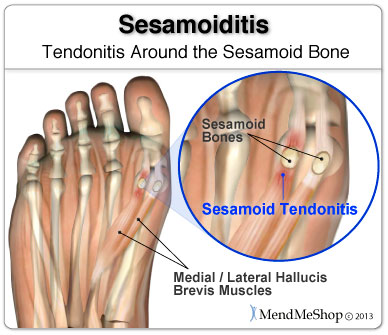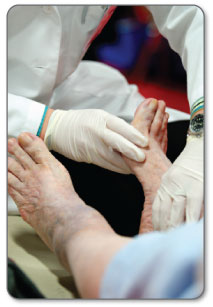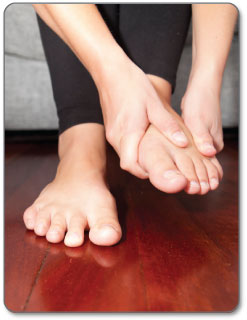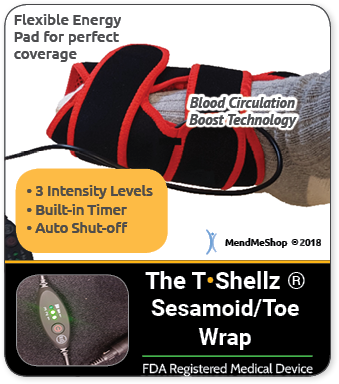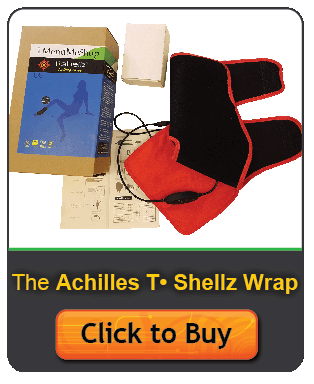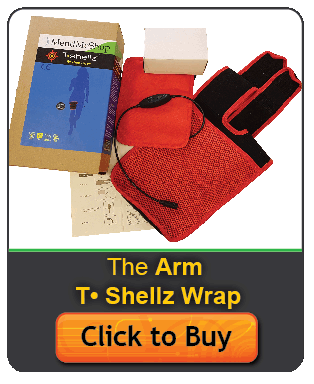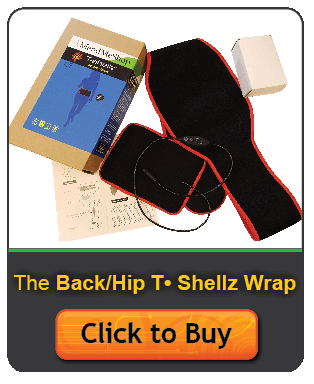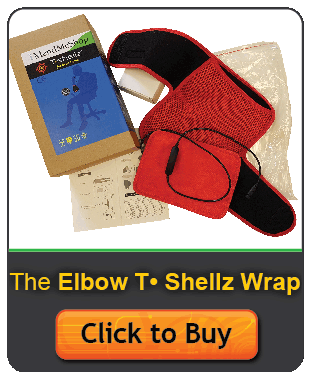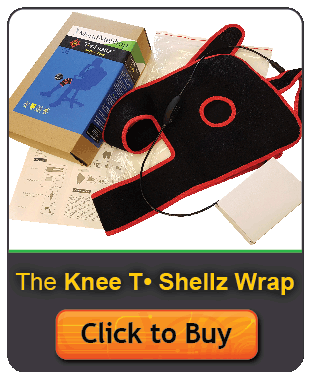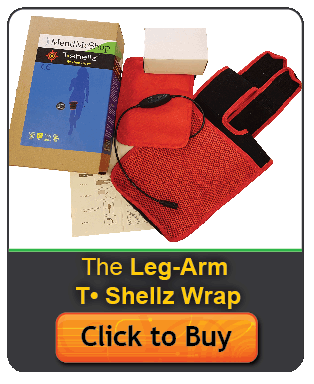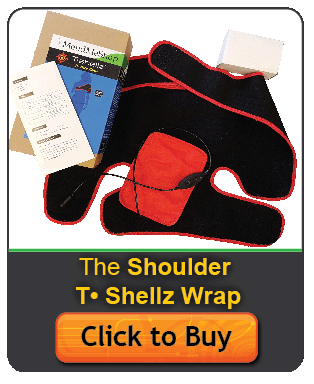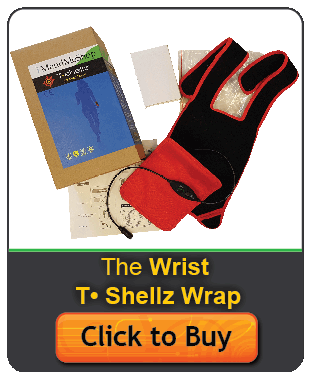Bursitis Injury Facts Part 2:
Normally, bursa are flat and contain very little fluid. An injured bursa however, is swollen with fluid and not so flat anymore.
The most common bursitis injuries are:
Prepatellar Bursitis (housemaid's knee),
Superficial Infrapatellar Bursitis (clergyman's knee),
Trochanteric Bursitis (hip),
Olecranon Bursitis (student's elbow) and
Subacromial Bursitis (shoulder bursitis).
Deep Bursae separate bare areas of bone from overlapping muscles.
Superficial Bursae separate bare areas of bone from skin or tendons.
Deep Bursae develop in the womb. Superficial Bursae develop within months to several years after birth.
Household names for various bursitis injuries include: Popeye's Elbow, Miner's Elbow, Weaver's Elbow, Housemaid's Knee, Hod-Carrier's Shoulders, Dustman's Shoulders, Student's Elbow, and Clergyman's Knee

Bursitis Injury Facts Part 3:
On occasion, bacteria can invade a bursa and cause an infection. An infected bursa is known as septic bursitis and can be life-threatening if left untreated. So make sure you see a physician!
Septic bursitis is most common in knee joints and elbow joints as the bursae in these locations are close to the skin and most susceptible to bacterial invasion.
It is not uncommon for bursitis to be misdiagnosed as arthritis.
Bursitis is best avoided by staying in shape, taking frequent breaks from repetitive or laborious tasks and cushioning joints if on them for long periods (ie. kneepads for gardening).
A Bursa can swell to a surprisingly large size. In cases of heavy swelling, your physician may choose to drain fluid from the swollen bursa. If a lump is present in chronic bursitis cases, excision may be required.
Clergyman's Knee comes from a more upright posture when kneeling in comparison to Housemaid's Knee. Patients suffering from gout or syphilis can be at higher risk of contracting Clergyman's Knee.
| An Overview of Intermetatarsal Bursitis
The metatarsal bursa is located at the base of the toes on the bottom of the foot. This bursa can be irritated when one metatarsal bone takes more load than the others, often through excessive repetitive movement, wearing high heeled shoes or wearing shoes that don't fit properly. When this happens, the soft tissue between the bone and the skin becomes compressed and inflammation in the bursa can begin. Walking barefoot on a hardwood or tiled floor without cushioning will increase pain noticeably due to the direct pressure on the metatarsal bursa.
Symptoms of Intermetatarsal Bursitis
Symptoms of Intermetatarsal Bursitis are somewhat similar to symptoms of Morton's Neuroma. (we explain more about Morton's Neuroma further down the page). You may be suffering from Intermetatarsal Bursitis if:
- You have sharp pain in the ball of your foot which is at the base of your toes, that causes you to limp.
- You feel a burning pain that shoots into the affected toe or area when walking or running. This pain will persist despite attempts to change footwear or reducing your activity levels that causes stress in the metatarsals.
- You may notice a lump that could cause you to have a toe out of alignment with the other toes.
- You will notice increased pain with any tight or compressed footwear.
- You have numbness or tingling in the toe(s).
- You may experience a feeling like you are walking on the bones of your foot or a feeling like there is a pebble in your shoe.
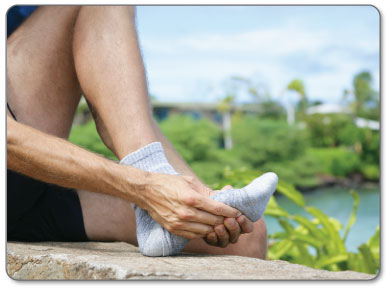 If any of those statements are true for you or you're suffering from on-going pain at the base of one or more of your toe(s) then you might have intermetatarsal bursitis. It's an injury that's not commonly heard of - people are more likely to understand that they might have plantar fasciitis, tendonitis or some other injury in their foot.
What Causes Intermetatarsal Bursitis?
Foot pain can often be quite complicated when trying discover what is really causing you to limp or even lose time at work. The foot is a very complex system of bones, tendons, ligaments, bursa and sesamoid bones - once you consider the fact that the feet support an extremely high load, often for very long periods of time, you can understand why it is important for them to function correctly. There are many causes of intermetatarsal bursitis - a few of the more common causes are outlined below:
A sudden impact to the area of the foot such as stepping on the ball of the foot incorrectly, or unknowingly stepping on an item (ie. a piece of Lego) that causes a lot of pressure on one area of the toe base.
A fractured bone that causes inflammation in the area including the bursa sac itself.
A injury to soft tissue surrounding the bursa sac can lead to a buildup of scar tissue. This scar tissue thickens the lining of the bursa, making it difficult to do it's job of lubricating the joint and allowing the tissues to glide smoothly. This causes added friction and leads to high risk of bursitis.
Poorly constructed or worn out footwear that does not have enough support for the ball of the foot adds stress and weakens local soft tissue. This soft tissue tightens around the bursa, causing irritation.
Poor foot structure - either genetic, from osteoarthritis, gout, or from a previous injury/accident will affect the way you walk. This misalignment of bones or weakened soft tissue can put excess stress on the bursa and potentially lead to bursitis.
Intermetatarsal bursitis can stem from a sports related injury when running shoes that are too tight or in sports that cause repetitive stress to the ball of the foot such as rugby, football and running sports in general. Playing running sports on hard surfaces causes excess stress on the metatarsals and as such, can increase the risk of incurring bursitis in the metatarsals.

Intermetatarsal bursitis is typically more noticeable in the winter months when wearing tighter shoes/boots. The added compression of this footwear can increase the risks of contracting this condition.
The condition most often affects women who frequently wear pointed, high-heeled, close-toed or poorly designed footwear. The pain increases with walking, weight-bearing movement, and tight-fitting shoes.
Do You Really Have Intermetatarsal Bursitis?
Visiting your doctor when you have foot, ankle or heel pain is always recommended, as there are many possible issues that can happen within the foot. Our feet are some of the most complicated joints in our bodies with 26 bones, 33 joints and more than 100 tendons, muscles and ligaments. Pain in the ball of the foot can be caused by many injuries and sometimes, one set of symptoms can result in multiple diagnoses.
Some conditions that can show similar symptoms to intermetatarsal bursitis:
- Stress Fracture - a break in the one of the bones in the toe or ball of the foot. Increased loads to the area causes the bones to weaken and micro fractures without rest the bones will completely fracture.
- Plantar Plate Tear/Strain - This condition usually causes sharp pain right under the toe, and your toe may be out of alignment with your other toes. The ligament that holds toe bones in place has become injured from toes being pushed in an upward motion or from activity such as standing on your toes.
- Morton's neuroma - If you have Morton's Neuroma, you are experiencing a thickening of soft tissue that surrounds the digital nerve leading to the toes and is generally caused by irritation, trauma or excessive pressure. Moreover, Morton's neuroma most frequently develops between the third and fourth toes. This condition usually causes burning pain in the ball of the foot that may radiate into the toes. The pain generally intensifies with activity or wearing shoes. You may sometimes feel that you are "walking on a marble," and you have persistent pain in the ball of your foot. You may also have numbness in the toes. Morton's Neuroma is sometimes misdiagnosed as a plantar plate tear as the two conditions have similar symptoms.
- Metatarsalgia - This condition can also cause pain in the ball of your foot - the area between your arch and the toes. Metatarsalgia is a common overuse injury, persistent stress can lead to chronic irritation and inflammation of the bone covering and surrounding tissues, such as ligaments and tendons. Metatarsalgia is generally not considered a medically serious condition though it certainly has the ability to keep you off your feet until it goes away.
- Sesamoiditis - The big toe has two very tiny bones embedded in tendon tissue in the ball of the foot. Any type of injury to the tendon tissue can cause irritation in and around the sesamoid bones. This condition can also cause pain in the ball of your foot, and into the big toe. Sesamoiditis is a common overuse injury, persistent stress can lead to chronic irritation.
- Plantar Fasciitis - Pain associated with plantar fasciitis normally starts as a dull ache and then progresses to a sharp, knife-like pain or constant throbbing feeling that is worse when you put weight on your foot. The most tender areas tend to be in the center of your heel and along the inside and bottom of your foot towards your toes, where your heel and arch meet.
- Turf toe - This can happen when the big toe joint is pushed beyond its' normal range (backwards or downwards). A 'pop' is felt at the moment the injury happens followed by sharp immediate pain. Symptoms include swelling in the foot, the entire big toe joint is affected and limits the range of motion in the toe.
- Predislocation syndrome, crossover toe deformity and floating toe syndrome are terms related to a plantar plate tear or sprain.
How Is Intermetatarsal Bursitis Diagnosed?
It's important to find out what's wrong with your foot. Injuries are often misdiagnosed as they are similar to some other injuries that affect the foot. This is very true for those who are very active or enjoy running sports.
When seeing your doctor they will discuss your medical history and your current condition and symptoms. He/she will ask about the amount pain you are having with your lower leg and foot. How long you have had your symptoms and if you are experiencing a range of motion loss or limp when walking/running. Details about what caused the pain in the foot, when it started, and whether or not you have ever had treatments for this or a similar condition in the past, are very helpful in assessing your injury.
Range of motion movements / tests will be done to see how much movement has been lost in your foot. Your feet might hurt from the doctor poking and prodding at it, but by doing this the doctor will better understand the source of your pain, the level of tenderness in the area and how well you can move with this condition.
Your physician will examine your foot, heel and ankle for any deformities or inflammation (swelling, redness, heat, pain). They will also look at your flexibility, stability, and gait (the way you walk). A positive Mulder's sign (wiki link) will often lead to a positive diagnosis and they will try and reproduce your symptoms.
Your doctor may also consider any previous foot/knee injuries or joint stiffness that you may have had in the past.
Occasionally an x-ray of your foot will help rule out other possible causes of your symptoms such as Metatarsal (toe) Stress Fractures. Possible causes of pain that an x-ray can identify include instability, abnormal bone shapes (bone spurs or bone cysts), wear and tear on the joints, avulsion fractures (when a fragment of bone tears away from the main bone along with the muscle, tendon, or ligament as a result of trauma), dislocations, arthritis, calcium deposits in the bursa or joint, and/or other problems.
An MRI can be used to provide a complete and accurate diagnosis of any injury to the soft tissue (ligaments) in your toes. In some cases the doctor will request blood tests to rule out diseases or infections.
What Is Overcompensation Pain?
Long-term changes in your gait (the way you walk) - like shuffling or limping to reduce pain around your toes, can impact other areas of your body and possibly result in something called 'overcompensation pain'. Over time, foot pain will often wreak havoc on your heel and knees due to lack of movement and over-compensation. It will also wreak havoc on your opposite foot as you will automatically try to minimize the weight put on the problematic foot. Recovery takes a longer time for such chronic (long term) injuries, but proper healing is essential to regain strength and get you back to the activities you enjoy.
The longer your injury endures, the greater the risk of running into serious overcompensation injuries.
Everything in the human body is connected. An intermetatarsal bursitis injury can lead to other injuries over time if not treated properly. You might start limping or shuffling because of your injured foot and place more weight on your opposite, healthy foot. Limping your way around for a long period of time may lead to pain in the heel of your foot, knee, hip or lower back on your injured side because you are mis-aligning your entire leg. The goal is to prevent secondary injuries while letting your toes heal. If you are changing the way you walk - try keeping your foot straight and off to the side to compensate for the injury.
Any injury left untreated can lead to overcompensation pain. Dealing with the injury quickly and healing completely should be your main focus. Properly healing bursitis in the foot takes time but you can speed up your can greatly assist in this recovery process by implementing conservative home treatment options such as a Cold Compress or Ice Pack, rest, a Localized Enhanced Circulation device such as the Sesamoid TShellz Wrap®, and a good stretching regimen.
Conservative Treatment Tools Our Clients Have Used to Help
Limit Damage & Boost The Body's Soft Tissue Repair Process at Home:
- A Cold Compress or Ice Pack to reduce inflammation of the bursitis (and likely tendinitis) as soon as possible.
- A TShellz Wrap® to increase blood-flow where you are experiencing bursitis (a Localized Enhanced Circulatory Response® Treatment).
- MendMeShop Arnica Pain Cream for a powerful, temporary relief of pain due to sore muscles and joints. If pain is keeping you awake, you might find it can help you get some sleep.
- A High Quality Support Brace to help immobilize the area while providing comfort, compression and support for the tendon.
- A High Quality Back Pillow and/or Knee Pillow for comfort while sleeping or sitting
- An Exercise & Stretching Plan to prevent muscle atrophy and shortened tendons. A proper plan will increase elasticity and strengthen the muscles and tendons of the affected joint.
Conservative treatment tools just like these have been used successfully by thousands of soft tissue injury sufferers - just like you.
TShellz Wrap® = Enhanced Blood Flow in the Treatment Area
We believe the use of TShellz Wraps® for boosting blood flow to tissue in the local area of application is one of the most under-utilized home treatment options available on the market today. We have client after client that have tried many options out there and have been amazed at how effective and fast the TShellz Wrap treatment can relieve pain and increase blood flow in the treatment area.
With regular use of the TShellz Wrap:
- Your pain will be reduced*.
- Due to increased blood flow, soft tissue in the treatment area will be expected to recover at an accelerated rate with reduced potential for re-injury*.
- Tissue in the treated area should experience a larger range of motion and increased extensibility of collagen tissue* due to the heat effect on soft tissue. This should translate into a reduced rate of re-injury occurrence as soft tissue is known to lengthen and become more flexible when exposed to warm temperature. (*Chapter 9 of "Therapeutic Heat and Cold", 4th edition.
(amazon.com link - Ed. Justus F. Lehmann, M.D., Williams, and Wilkin)
Intermetatarsal Bursitis Home Remedies
In the following section, we outline effective conservative treatments for Intermetatarsal Bursitis
Many cases of bursitis in the foot will heal by elimination of poor fitting footwear and the incorporation of simple home conservative treatments. Surgery is often not needed for dealing with bursitis and is typically considered as a last option resort.
It is generally understood by doctors and surgeons that surgery will introduce more scar tissue into tendons and ligaments (soft tissue) in your foot. This added scar tissue will be problematic, requiring PT and conservative treatment options post-surgery. When it comes to bursitis there's only a few surgical options for treatment - removal of the bursa sac, scraping of the bone(s) to allow more room for the new bursa to grow back. This is why surgery is only performed as a last resort for chronic bursitis that has not responded to 2 to 4 months of conservative treatment methods.
Conservative treatment methods recommended include:
- Rest - This is important for initial recovery; rest and elevation will help reduce pain, swelling and inflammation in the early stages of injury. This can be difficult when you have to carry on with daily activities, but resting and elevating your foot whenever you can is recommended. During your recovery you will probably have to modify or avoid the activities that put stress on your calf, lower leg & foot until your pain and inflammation settles. However, too much rest can also be harmful to such injuries because knee, ankle and foot immobility can actually cause stiffening in the joints. This is why rest should be used when reducing initial pain and swelling, but should not be considered for more long-term conservative treatment.
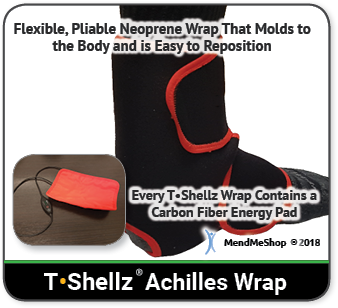 - Avoid Activities that Caused Your Bursitis - While resting your foot it's also important to avoid all activities that may have caused or exacerbated the problem (especially any strenuous or repetitive movement). Continuing on with such activities will likely increase the severity of your injury (ie. wearing high heels or poor fitting footwear), turning a mild to moderate case of tissue damage into a downward spiral of worsening damage that may eventually severely impact your life. Also, trying to 'work around' your injury will eventually give rise to over-compensation injuries in other areas of your body.
- Use a Cold Compress or Ice Pack - Cold is very effective at reducing pain and inflammation - use at the onset of the injury and during flareups. Immediate pain relief and reduced inflammation can also relieve some of the pressure that's being placed on your bursa although cold can also shorten tendons, causing more friction on the bursa sac. Generally, use cold when there is swelling but stop if you notice pain levels rising.
- Use a Sesamoid TShellz Wrap® (Circulatory Boost device)- Once swelling has been reduced, you can use your own blood flow to maximize your rehabilitation. Improved blood flow to your foot in most cases will help improve recovery time while improving overall health of soft tissue in the area. Knowing the body uses blood flow to heal soft tissue, this wrap is intended to maximize your rehabilitation by maintaining a healthy blood flow to the treatment area. Increased blood flow to damaged soft tissue improves the bodys' own repair process, helping decrease recovery time while reducing re-injury risk. Promoting blood flow and heat to the treatment area will help to minimize the growth of scar tissue, increase tissue flexibility and help reduce onset of atrophy. This is why we recommend a TShellz Wrap treatment before undergoing activity - an increase in flexibility should help reduce risk of further injury while also assisting in the battle against atrophy. Heat via the TShellz Wrap® is especially helpful in dealing with chronic tendon & muscle injuries or on-going pain and stiffness from a strained foot or ankle.
- Rehabilitative Stretching under supervision of a PT or doctor. The intent of this is to provide you with increased range of motion, pain relief and strengthening of the surrounding tissue of the joint. Doctors or surgeons typically won't perform a surgery until they feel that their patient has put effort into treating their injury with conservative treatment methods. This may include up to 4 to 6 months of visits to a PT clinic. If you haven't experienced any improvement in your condition during that time then surgery may be considered.
- Stretching - Stretching your foot in PT and at home will help you to regain your range of motion much faster than not stretching at all. Stretching in many ways is key maintaining good Range of Motion (ROM) in your joint, and stretching can be made much easier with use of a TShellz Wrap® before to warm up soft tissue, and a Cold Compress or Ice Pack treatment after to prevent any return of swelling and inflammation.
General Guidelines for Dealing with Bursitis in the Foot
It is important to treat bursitis in the early stages to reduce the symptoms, minimize damage and maintain a normal walking pattern. Resting your foot and reducing any activities that add pressure on your bursa will help to reduce your pain and bursitis inflammation. By treating your intermetatarsal bursitis in the early stages with conservative treatment methods, you are more likely to prevent long-term damage and chronic conditions from setting in.
Surgery to remove the inflamed bursa is normally not required for bursitis, however if you fail to see improvement with the conservative treatments, your physician may recommend surgery to remove the bursa completely. Although this removes the problem of an inflamed bursa, you are left with less lubrication in your foot which can lead to a host of other conditions.
An important factor in healing bursitis is resting your foot. During your recovery you will probably have to modify or avoid the activities that stress your bursa until your pain and inflammation settle.
Treatments should involve decreasing swelling, relieving pain and stress on the foot, treating scar tissue, and then restoring movement. If you are performing an activity that could cause further trauma to the bursa, it is recommended that you protect the area to prevent further irritation or damage.
Regardless of the condition affecting your foot, you will find that conservative treatments your doctor provides are the best choice for a healthy recovery. Building strong healthy tissue allows you to regain strength and full range of motion with your walking.
The Plantar/Spur TShellz Wrap and Sesamoid TShellz Wraps are home treatment medical devices that have pleasantly surprised many of our customers. Even with chronic cases such as arthritis - these products cannot cure arthritis, but they sure can bring down the swelling (and pain) when it flares up. Maintaining elasticity in the joint is a major concern for arthritis sufferers, and the TShellz Wrap will help fight atrophy (shrinking of soft tissue due to lack of movement) and strains as it is known to increase elasticity of soft tissue during and for some time after treatments. This is why we recommend TShellz Wrap® treatments before engaging in an activity that may stress the injured area (ie. stretching). You simply won't find another product on the market that has the comfort, ease of use, and effectiveness of a TShellz Wrap.
Foot Support Aids For Intermetatarsal Bursitis
A cushioned athletic shoe with a wide toe-box may relieve pressure on your intermetatarsal bursitis injury.
- Wearing wide toe-box, cushioned athletic shoes gives your foot more room. Wearing a stiff-soled shoe like clogs can help to reduce the pressure being placed on your bursa tissue. For some people, a soft-soled shoe (like flip-flops) are even more comfortable and reduce the pain. If you've recently started wearing a new pair of shoes with a different type of arch support insole then this might even be the reason why you now have foot pain.
- Put Orthotics in Your Shoes - Use of any kind of orthotic or insert for added support in your shoe should always be done through the recommendation of your doctor. There are certain shapes of padded inserts / orthotics that are designed to relieve pressure on the bursa sac and keep foot aligned. You have to be careful with your choice of orthotics and may need to get some custom-made by your doctor because there's always a possibility that using the wrong orthotics will make your injury worse. Plantar metatarsal pad's may by be recommended by your doctor.
Reduce Pain & Swelling with a Cold Compress or Ice Pack
The 2nd step for conservative treatment of your intermetatarsal bursitis when treating conservatively or even after surgery is to reduce swelling to "open up" the area for more blood flow. Anyone in the health-care business knows that your blood supplies the oxygen and much needed nutrients required for your body to heal naturally after surgery. This is why doctors and surgeons recommend cold compression within the first 72 hours of any injury and following surgery.
Cold compression is recommended to reduce pain, swelling and tissue damage. Many doctors, surgeons and physical therapists consider cold compression to be the gold standard for treatment of inflammation and pain. On-going cold compression treatments can reduce, or even eliminate, the need for NSAIDs or other medications that can be harmful to your body.
Cold compression is known and trusted by most medical professionals. This is why for years doctors, trainers and other medical professionals have recommended RICE (Rest, Ice, Compression, Elevation) to treat the pain and swelling of fresh injuries, chronic pain, after any re-injury, and especially after surgery.
Use a Cold Compress or Ice Pack:
- 24 to 72 hours after your initial injury or when you first notice pain and swelling around your injured area to stop tissue damage, relieve pain, and decrease swelling.
- After exercise, workouts or activity of any kind to prevent re-injury.
- Before and after surgery during rehabilitation to control pre and post-surgery pain and swelling.
- Anytime you feel your intermetatarsal bursitis injury is making your injury feel tender, painful or you're having a flare-up of an old injury.
- Anytime you have swelling, sharp throbbing pain or inflammation.
- Any other situation where you need to draw the pain and inflammation out of your soft tissue.
Improve Circulation, Soften Scar Tissue & Prevent Re-Injury with Circulation Boost
- Have you recently re-injured yourself by returning to your normal daily activities too quickly?
- How many times in the past have you aggravated yourself just trying to perform basic tasks around your house?
- Is your injury preventing you from work or activities you love to do?
... if this sounds like you - you're not alone...
Most people we deal with tell us these scenarios have happened to them many times in the past. The real challenge is how to promote blood flow to your injury site without causing further damage. This goal is even more complicated by the fact that you have to use your injury site for almost everything in everyday life.
There are a lot of people that think their injury is gone after their swelling and inflammation are gone and their injury feels better. They also make the mistake of returning to regular activities too soon without proper time for healing. The truth is that healing takes time and after the swelling is gone your injury isn't even close to being fully healed.
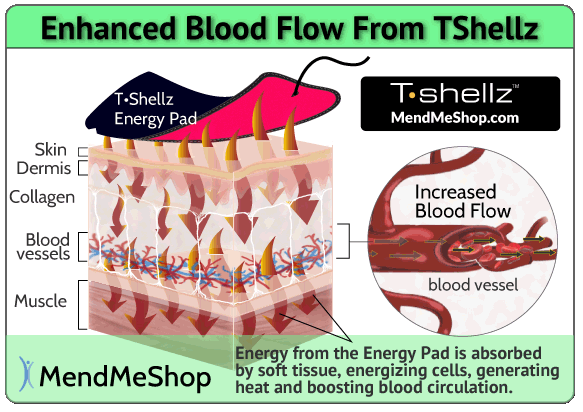
Once the inflammation in the ball of your foot has been reduced via a Cold Compress or Ice Pack it is time to take the next step in your treatment. Use a Sesamoid TShellz Wrap® to improve blood flow while simultaneously helping surrounding soft tissue to become elongated and more elastic. What this means is that not only is increased blood flow helping the intermetatarsal bursae and surrounding soft tissue to heal, the tendons/muscles/ligaments are now longer and more elastic due to the heat effect of the treatment. This, in turn, reduces pressure and friction on the bursae while simultaneously reducing the risk of atrophy (weakening of the muscles and tendons) in and around the ball of your foot and toes. The TShellz Wrap® is a perfect tool to use at home to augment your massage and PT sessions, reduce the risk of re-injury and help keep your blood moving. Believe it or not, the best time for you to focus on avoiding re-injury and strengthening the weakened tissue is when the swelling's gone and your tissue has started to heal. It's vital that you don't go back to activities too soon because you might bring on a major setback in your recovery...
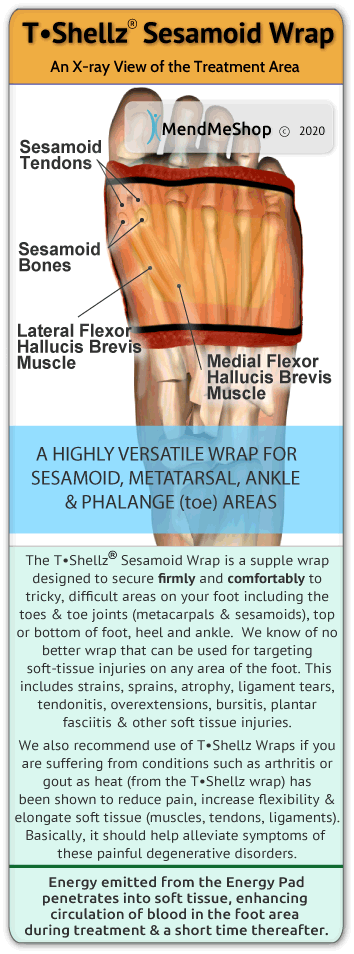 Improved blood flow helps reduce the risk of atrophy in muscles, tendons and ligaments. When you stop moving/using your feet and toes due to pain, your muscles and other tissue can become weaker and dead tissue and toxins in the area can cause further tissue deterioration - this can lead to atrophy in the foot and increase the risk of contracting more issues such as achilles tendonitis or plantar fasciitis. Furthermore, foot pain will also increase risks of overcompensation pain - basically the result of increased use of the opposite foot and knees/hips due to the change in gait (the way you walk). The Sesamoid TShellz Wrap® is an amazing and versatile tool that can be used anywhere on your foot or ankle, so you can use it for multiple areas if needed. We also have TShellz Wraps® for every major joint of the body, so if your knees or hips are causing trouble, we can help there too!
By clearing the area of toxins and increasing the amount of oxygen and nutrients to the soft tissue in your foot, the risk of atrophy (muscle weakness and/or deterioration) is greatly reduced. Keeping your foot and ankle as healthy as possible throughout the healing process will allow you to improve strength again once your pain has gone and your IT band has healed.
Promoting blood flow around injured tissue to help the body heal itself is a concept that's been used for centuries. Oxygen and nutrients, carried in your own blood, are critical for the body to heal itself. Without proper blood flow, your recovery rate from a soft tissue injury will be minimal, easily turning a 6 week recovery into long term deteriorating chronic nightmare due to re-injury, scar tissue and atrophy.
How Do You Use a TShellz Wrap® (Heat) For Your Foot?
HEAT (warmth) is used after you've reduced your swelling / inflammation and the sharp pain is less intense (you have more of a dull / nagging ache and soft tissue tightness in your foot). Warming up tissue in the area is a natural way to encourage healing of bursitis and surrounding tissue. It's the blood in your body that will bring oxygen, nutrients and water (basically energy) to your injured tissues to help maximize your body's healing process.

When heat is applied to the metatarsals area (toe joints), arteries will expand to allow more blood flow through to your damaged or torn soft tissue. This in turn relaxes your foot, making the tissue more flexible and elastic. This is why heat is used on older (chronic) injuries, to loosen tissue and bring in the blood flow that your body requires. Your body will begin to heal itself after it is injured, and for the majority of people, increasing your blood flow with heat will speed up this natural process - often surprisingly well.
Doctors usually call this process 'Vasodilation'.
NOTE: Heat is NOT a good treatment method for inflamed soft tissue, new injuries (within the first 24 to 72 hours), right after surgery or right after a re-injury (over-use and/or sharp, throbbing pain). In these cases, heat should be applied later on in the healing cycle. In the meantime, use a Cold Compress or Ice Pack to decrease any inflammation induced pain.
When To Use Heat to Treat Your Injured Foot
A TShellz Wrap® temperature treatment works best to increase blood flow circulation for older (chronic) injuries, re-injury (after swelling has been reduced) and during long-term post surgery recovery. Warmer temperatures should be used approximately 3 to 5 days after you first have the injury. Heat should not be started after surgery until your physician approves because inflammation levels will be very high as the healing process starts over again. Generally speaking, this could be 6 weeks or later. Any use of heat should also be combined with gradual movement to stretch out your foot and increase range of motion.
If you have a chronic tendinitis and/or bursitis in your metatarsals that keeps getting re-injured, it is advised to use heat before activity to loosen up your tissue (making it more flexible). When used at this time the warm temperatures naturally extend the elasticity (elastic-nature) of the joint, making it more movable / pliable for activity.
Sometimes we feel pain while doing a certain activity - should you still use heat? Using heat in the morning before you start your day or before activity can help to boost the healing process and reduce your risk of re-injury. Too much heat (especially when you suffer a set-back with swelling / inflammation) can make your inflammation worse. Cold treatments with a Cold Compress or Ice Pack should be used part-way through your day when you suffer from on-going pain and inflammation as a natural pain-reliever.
Use the TShellz Wrap® before activity and/or when you notice any stiffness in your foot to 'warm up' your muscles, tendons & ligaments to minimize risk of strain, spasm or re-injury during activities.
Regular treatments with a TShellz Wrap (heat) can reduce pain and stiffness from scar tissue and increase overall flexibility in your tissue. Increased blood flow will whisk away damaged tissue, toxins, and any bacteria in or around your injured tissue to promote an efficient recovery. Getting rid of toxins will allow all of the positive healing processes to start in your injury. Increasing blood flow will also increase the amount of oxygen that's being sent to your injured tissue AND boost your tissue's ability to absorb oxygen. (reference: 1)
Use a TShellz Wrap®:
- After swelling and inflammation have been reduced with cold compression.
- BEFORE getting out of bed in the morning. BEFORE going to bed at night.
- BEFORE exercise, workouts or activity of any kind to increase elasticity of tissue in the area which in turn reduces your risk of further injury/re-injury.
- Anytime you feel your bursa site may have stiffened up, is tight and your mobility is reduced causing you more pain.
- Anytime you have sore or aching tissue as long as there is not substantial swelling.
- AFTER surgery (once the skin wound has healed over and swelling has reduced - basically at least 6 weeks after the surgery) to boost blood circulation, helping surgically repaired tissues recover for long-term health and minimize scar tissue growth at the surgery location.
- Anytime BEFORE you feel you might undertake activity that will put significant strain on the injury area.
- Any other situation where you need to increase blood flow to relax your tissue, relieve pain, prevent re-injury and enhance flexibility in the area.
Click HERE to Go To Our Online Store We take all major credit cards and Paypal.
If you have questions, call our office at 1-866-237-9608 (toll free continental US).
We are currently offering FREE SHIPPING and a 60 day trial period on all our Wraps.
Anti-Inflammatory Medications for Intermetatarsal Bursitis
NSAIDs, non-steroidal anti-inflammatory drugs, can be used if required to help manage your pain. However, these aren't recommended for long term use, as they can cause gastrointestinal difficulties and increase the risk of cardiovascular disease. The TShellz Wrap®, when used in conjunction with NSAIDs can greatly improve the effect of the medication; this can not only help you heal quickly but also reduce the amount of NSAIDs that you ultimately may require.
...A Quick Recap of Benefits That Can Be Achieved Via the TShellz Wrap®..
- We have TShellz Wraps® that can fit on the back, hip, leg, arm, shoulder, knee, plantar, toes, wrist and ankle
- It can be used before exercise to warm up the problematic joint to reduce the risk of injury (heat elongates soft tissue and makes it more flexible)
- FDA Registered medical device for use in home or clinics - high quality, 1 year warranty, 60 day trial period (100% refund guaranteed)
- Increases temporary flexibility and length of tissues (reducing the re-injury factor)
- It soothes pain and whisks away toxins
- Carbon fiber Energy Pad is strong, lightweight, and flexible - contours very easily
- A boost in blood flow helps maximize the body's ability to recover from soft tissue damage. This can be beneficial in saving time and money when associated with doctor or physio visits
- A boost in blood flow will maximize the body's ability to recover quickly. This can be beneficial in post-surgery rehabilitation, getting you back to work faster. Do not use until at least 6 weeks after surgery, and only after approval from your doctor.
Foot Bursitis Home Remedy Options
Suggested Conservative Home Treatments to Help
Speed Up Healing of Bursitis
Many cases of bursitis in the foot will heal by elimination of poor fitting footwear and the incorporation of simple home conservative treatments. Surgery is often not needed for dealing with bursitis and is typically considered as a last option resort.

It's generally understood by doctors and surgeons that surgery will introduce more scar tissue into tendons and ligaments (soft tissue) in your foot. This added scar tissue will be problematic, requiring PT and conservative treatment options post-surgery. When it comes to bursitis there's only a few surgical options for treatment - removal of the bursa sac, scraping of the bone(s) to allow more room for the new bursa to grow back. This is why surgery is only performed as a last resort for chronic bursitis that has not responded to 2 to 4 months of conservative treatment methods.
Some conservative treatment methods recommended include:
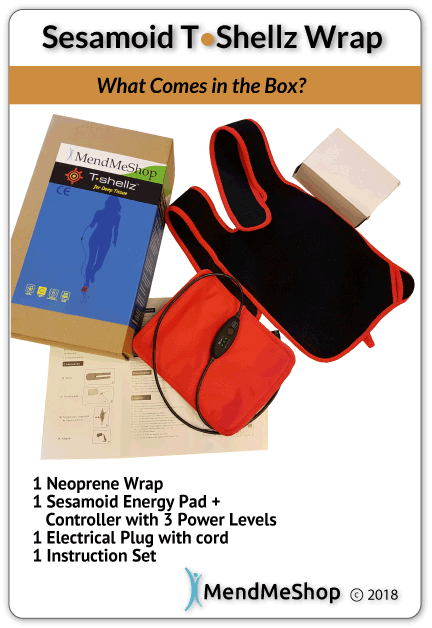
Product Advisors are available 9:00 am to 5:00 pm Eastern Standard Time Monday to Friday.
Learn More About Bursitis Injuries & TreatmentsI want to learn more about Post-Surgery Recovery I want to learn more about TShellz Wrap® Circulatory Boost I want to learn more about Ice & Heat: Which Is Better For Treatment? I want to learn more about Bursitis Treatments I want to learn more about Bursitis Surgery
FREE SHIPPING ON ALL PRODUCTS CURRENTLY ENABLED
60 DAY TRIAL PERIOD
During your recovery, you will probably have to modify and/or eliminate any activities that cause pain or discomfort at the location of your soft tissue injury until the pain and inflammation settle. The more diligent you are with your treatment and rehabilitation, the faster you will see successful results!
|
Bursitis Inflammation Facts:
Bursitis is the inflammation or irritation of the bursa.
Bursitis is most often caused by repetitive, minor impact on the area, or from a sudden, more serious injury.
Bursitis high-risk activities include gardening, raking, carpentry, shoveling, painting, scrubbing, tennis, golf, skiing, throwing, and pitching.
If bursitis persists and is left untreated, calcium deposits can form within the bursae. These calcium deposits limit range of motion and can lead to a permanently stiff joint.
Incorrect posture at work or home and poor stretching or conditioning before exercise can also lead to bursitis.
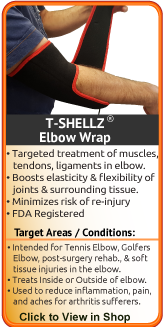

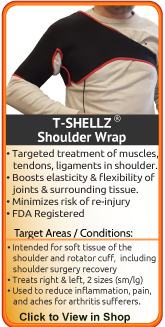

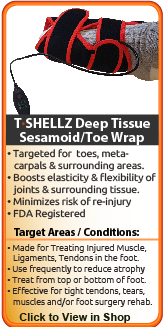
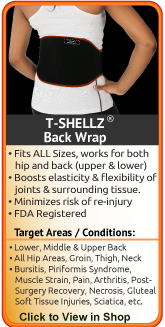

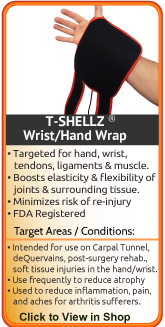
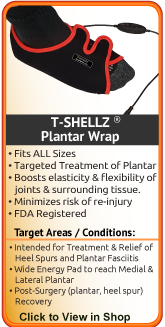







|


